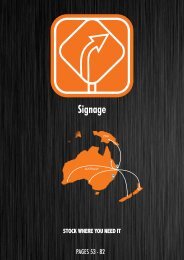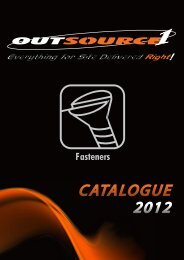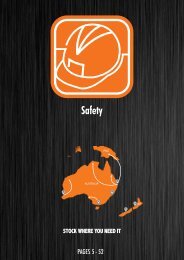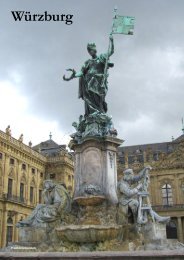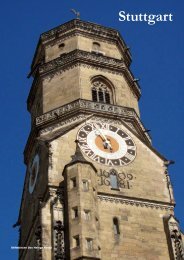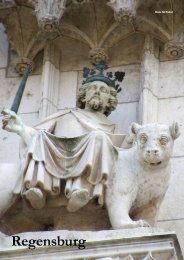Raven Guides: Germany - Trier
- No tags were found...
Create successful ePaper yourself
Turn your PDF publications into a flip-book with our unique Google optimized e-Paper software.
Liebfrauen-Basilika<br />
<strong>Trier</strong>
<strong>Trier</strong><br />
<strong>Trier</strong> at its height was one of the<br />
great cities of the Roman empire<br />
and many signs of that greatness<br />
remain.<br />
<strong>Trier</strong>’s claim to be the oldest city in <strong>Germany</strong><br />
is justifiable. It has the Roman baths, amphitheatre,<br />
bridge and a Roman city gate – the<br />
Porta Nigra, unique in its state of preservation<br />
– to support the boast. It also has <strong>Germany</strong>’s<br />
oldest cathedral and probably its oldest palace.<br />
Though established by the emperor Augustus<br />
and named Augusta Treverorum for the<br />
Gaulish Treveri tribe, the city had first been a<br />
river crossing in 17BCE and grew during the<br />
1st century reign of Claudius. The Treveri, a<br />
thorn in the side of Rome since the time of<br />
Julius Caesar, were not pacified until 70AD.<br />
<strong>Trier</strong> weathered the attacks of the Franks<br />
and Alemanni in the 270s and became home<br />
to Roman emperors including one of the<br />
mightiest, the Constantine the Great. It was<br />
briefly second only to Rome, with Roman<br />
administration and Romanised Gallic citizens.<br />
Its position near the Rhine frontier of<br />
Germania led to its selection as one of four<br />
centres of what was later termed the Tetrarchy,<br />
a system of ruling through four emperors in<br />
a succession system put in place late in the<br />
3rd century. Constantius I Chlorus ruled the<br />
western Roman empire, including Britannia,<br />
from <strong>Trier</strong>.<br />
Constantine, Constantius’ son, beat off<br />
further Frankish assaults and set about building<br />
up <strong>Trier</strong>’s walls and palace precinct – work<br />
never completed – but he had more influence<br />
on the spread of Christian beliefs than anyone<br />
since Christ. His own adoption of the faith,<br />
with his institutionalisation of tolerance, was<br />
a crucial moment in Western history. He sent<br />
his mother Helena on a mission to the Holy<br />
Land and she reportedly returned with the<br />
Robe worn by Christ, which became an object<br />
of pilgrimage and now is kept within the vaults<br />
of <strong>Trier</strong>’s cathedral.<br />
Constantine left for the east in 316 in a<br />
successful quest to reunite the Roman empire<br />
– <strong>Trier</strong>’s loss was the birth of Constantinople,<br />
as well as the survival of Rome.<br />
The Porta Nigra survived even Rome. It<br />
was one of four city gates to a street grid that<br />
included bath complexes and a forum (now<br />
vanished, in the area north of Kaiserstraße).<br />
The site of two Roman basilicas were later<br />
occupied by the cathedral and Liebfrauenkirche<br />
(now branded the Liebfrauen-Basilika).<br />
An-other basilica, used as a throne hall and<br />
which survives, was later used as part of the<br />
palace complex of the elector-archbishops.<br />
<strong>Trier</strong>’s baths and amphitheatre are some of<br />
the city infrastructure that remains to inspect<br />
today. Mosaics, columns and statuary are<br />
among the finds displayed in the Rheinisches<br />
Landesmuseum. Given all this heritage <strong>Trier</strong>’s<br />
UNESCO world listing seems self-evident.<br />
Briefly under Valentinian I in the 370s<br />
<strong>Trier</strong> was again a principal residence but after<br />
the 4th century Rome withdrew and civic<br />
institutions began a slow decline in the face<br />
of Frankish pressure, then Frankish rule. The<br />
city maintained reduced importance under<br />
The Dom St Peter is <strong>Germany</strong>’s<br />
oldest cathedral.<br />
RAVEN QUICK GUIDE<br />
Tourist information: Simeonstift, Simeonstraße (tel 0651-978080, Jan-Feb M-Sa 10-17,<br />
Su 10-13, Mar-Apr & Nov-Dec M-Sa 9-18, Su 10-15, May-Oct M-Sa 9-18, Su 10-17).<br />
Accommodation service: tel 0651-9780816, email hotel@trier-info.de.<br />
Money: Sparkasse <strong>Trier</strong>, Simeonstraße 55 (M-F 8.30-16.30); Commerzbank,<br />
Simeonstraße 58 (M & W 9-13, 14-16, Tu & Th 9-13, 14-18, F 9-14).<br />
Lockers: Hauptbahnhof (€3.50/2.50 per day).<br />
Transit information: SWT Stadtbus Center, Treveris Passage 16 (M-F 8.30-18, Sa<br />
10-15.30).<br />
Post: Simeonstraße 11 (M-F 9.30-18, Sa 9.30-13); Moltkestraße 21 (M-F 8.30-18, Sa<br />
8.30-13).<br />
Internet: PTT Call Shop, Paulinstraße 7 (M-Sa 9-22, Su 10-22).<br />
Laundry: Wasch Salon, Brückenstraße 21 (M-Su 8-22).<br />
Police: tel 110; Salvianstraße 9 (tel 0651-97790); Egbertstraße 18 (tel 0651-2006880).<br />
Pharmacy: Löwen Apotheke, Hauptmarkt 6 (M-F 8-19, Sa 9-18); Stern Apotheke,<br />
Bahnhofstraße 32 (M-F 8-18.30, Sa 9-13); Gangolf Apotheke, Fleischstraße 9 (M-F 8-19,<br />
Sa 9-18).<br />
Ambulance: tel 112.<br />
Hospital: Krankenhaus der Barmherzigen Brüder, Nordallee 1 (tel 0651-2082260);<br />
Evangelisches Elisabeth-Krankenhaus <strong>Trier</strong>, Theobaldstraße 12 (tel 0651-20920).<br />
© 2014 RAVEN TRAVEL GUIDES GERMANY<br />
RAVEN TRAVEL GUIDES GERMANY - <strong>Trier</strong> 1
egional counts. Its main significance was<br />
as an archdiocese and river port as Rome’s<br />
memory faded and its ruined buildings became<br />
a handy source of stone.<br />
After further attacks by river-borne vikings<br />
in 882, the city marketplace on the Moselle<br />
banks was moved to the present Hauptmarkt,<br />
with rights eventually assigned by the German<br />
crown to the archbishops. But by the 11th<br />
century whatever was left of the Roman walls<br />
was not enough and in a sign of insecurity<br />
defensible residential towers were begun by<br />
influential families, eventually numbering<br />
about 20 even as a new, smaller town wall<br />
circuit was being thrown up, the northern part<br />
of it on Roman remains.<br />
Christian foundations had existed on the<br />
fringes of <strong>Trier</strong> even before Constantine<br />
and after monasticism began to grow. One<br />
of the earliest foundations, south of the city,<br />
maintains the burials of early <strong>Trier</strong> saintbishops<br />
and from the 12th century claimed<br />
the relics of St Matthew. The pilgrimage<br />
that developed around these conferred fresh<br />
importance and the pope Eugene III mounted<br />
an official visit that also had much to do with<br />
the assertion of the archbishops’ primacy over<br />
the crown’s representatives.<br />
The prestige of its archbishops became<br />
the city’s main power asset and in 1257 <strong>Trier</strong><br />
became one of the electoral principalities of<br />
the Holy Roman empire, confirmed in 1356.<br />
Internally, episcopal rule caused repeated<br />
friction between townspeople and the Catholic<br />
church, which nonetheless retained complete<br />
control through the Reformation. In the 15th<br />
century a university was opened.<br />
<strong>Trier</strong>’s city fathers aspired to free-city<br />
status under the German emperor but were<br />
frustrated, with the small comfort that the<br />
elector-archbishops began to show a preference<br />
for life in Koblenz. Perhaps it was safer, for<br />
the forces of the French kings, notably Louis<br />
XIV, were a constant threat and amid attacks<br />
and occupations several of <strong>Trier</strong>’s monasteries<br />
and churches were ravaged and destroyed. In<br />
1688 the French unleashed invading troops<br />
and <strong>Trier</strong> was under French control from 1794<br />
to 1814, a period during which the electoral<br />
state was abolished and the university closed.<br />
French power was displaced only by Prussia<br />
after the defeat of Napoleon. Now <strong>Trier</strong>’s<br />
Catholic majority was left smarting under<br />
Protestant domination (which was ended only<br />
by the peace after World War I).<br />
In this Prussian era Karl Marx was born<br />
into comfortable bourgeois circumstances in<br />
the Brückenstraße house now maintained as a<br />
museum of his life, ideas and legacy. Growing<br />
up surrounded by reminders of empires fallen,<br />
he cannot but have wondered on the course of<br />
events and the path of revolution. In 1836 he<br />
left <strong>Trier</strong> to make his own history.<br />
After 1918, the French returned as<br />
occupiers and stayed until 1930, by which time<br />
the Nazis were not far away. World War II’s<br />
fiercest raids came in 1944, which grievously<br />
damaged the city and its Roman and medieval<br />
heritage sites but the Roman bridge was saved,<br />
being quickly crossed by US forces in March<br />
1945.<br />
Altstadt<br />
<strong>Trier</strong>’s city centre connects the Classical and<br />
medieval worlds. A walk should begin at the<br />
Porta Nigra, last survivor of the Roman city<br />
gates. A stroll south on Simeonstraße brings<br />
The Porta<br />
Nigra (c200) at<br />
Porta-Nigra-Platz<br />
on Nordallee was<br />
the northern of the<br />
four gates to<br />
Roman <strong>Trier</strong> and<br />
its arches spanned<br />
its main north-south<br />
road (marked today<br />
by the footings of<br />
part of the Roman<br />
colonnade). Both<br />
gate towers were<br />
originally 30m high<br />
and four-storeyed<br />
but the gate never<br />
received its full<br />
finish. The stone<br />
has blackened since the Roman period, giving the structure its present name – the Roman<br />
name has gone unrecorded. The gate arches were sealed, the ground floor filled in and the<br />
structure remodelled in the 11th century for use as the monastery church of St Simeon,<br />
named for a hermit from Syracuse who had lived in its ruins. But the invading Napoleon<br />
early in the 19th century recognised its antiquity and stripped the modifications (apart<br />
from the church apse), just as some of the Roman components had been stripped from the<br />
structure in the medieval period. The structure (Apr-Sep M-Su 9-18, Mar & Oct M-Su<br />
9-17, Nov-Feb 9-16, €3/1.50, families €6), with remnants of the sentries’ walkways,<br />
Roman inscriptions and the church can be inspected using the entrance next to the<br />
attached Simeonstift and museum. Take bus 1, 2, 3, 4, 5 or 12 to Porta Nigra.<br />
Italian town style of the medieval period also left its<br />
mark on <strong>Trier</strong>’s architecture. The oldest of the<br />
Simeonstraße houses, No 19, is the Romanesque-<br />
Gothic tower house Dreikönigenhaus, (facade c1230),<br />
now named for the Three Magi but formerly known as<br />
Zum Säulchen, probably for its gable column. It was<br />
restored in the 1970s to a 13th century colour scheme.<br />
The door, one storey above ground, offered security<br />
or defensive advantages as it could be reached only by<br />
portable steps or a ladder. Take bus 1, 2, 3, 4, 5 or 12<br />
to Porta Nigra.<br />
The Porta Nigra was aligned with the irregular<br />
Roman wall of more than 6km, sections of which<br />
can be traced along Nordallee and Friedrich-<br />
Ebert-Allee, complete with bastions. The line of<br />
the wall in this sector was renewed in the<br />
12th century, effectively what is visible today.<br />
Take bus 1, 2, 3, 4, 5 or 12 to Porta Nigra. The<br />
west wall led further along Schießgraben, where<br />
walls are also visible today, toward the Moselle,<br />
through the former St Irminen convent and along<br />
the east bank past the Römerbrücke. The south<br />
Roman wall was gated at today’s Saarstraße near<br />
Töpferstraße, swinging north-west to include the<br />
amphitheatre and the present Christophstraße.<br />
On an ancient monastery site, the church St Paulin<br />
(M & W-Sa 9-17, Tu 11-17, Su 10-19.30) at the square<br />
on Balthasar-Neumann-Straße north of the city centre<br />
took more than two decades in the building before its<br />
completion (1757) to the designs of Balthasar Neumann.<br />
Conceived as a complete Baroque work, it is dedicated<br />
to Mary, the bishop Paulin and the Theban Legion, said<br />
to have been martyred while marching to Gaul in 286<br />
because of its soldiers’ commitment to Christianity and<br />
refusal to renounce their faith. The original organ (1756)<br />
has been restored and the wooden altar sculpture is by<br />
Ferdinand Tietz. The rich ceiling frescoes of the patrons<br />
and martyrs are by Thomas Scheffler. Take bus 1 to<br />
St Paulin.<br />
<strong>Trier</strong> 2 - RAVEN TRAVEL GUIDES GERMANY
the visitor roughly along the route of the<br />
Roman main street to the historic facades<br />
and monuments of the medieval city centre<br />
Hauptmarkt. The short Sternstraße leads east<br />
to Domfreihof, where the Dom St Peter and<br />
Liebfrauen-Basilika occupy the same site as<br />
Roman structures.<br />
Liebfrauenstraße stretches south toward<br />
Konstantinplatz, where the reconstituted<br />
Konstantin-Basilika stands as a monument<br />
to the first Christian emperor, again on a site<br />
occupied by the governors and administrators<br />
of <strong>Trier</strong> for almost 2000 years.<br />
South along the paths of the Palastgarten<br />
is the baths of the Kaiserthermen, another of<br />
the impressive remains of Roman civilisation<br />
and another that went unfinished. But it served<br />
as a bastion for a medieval south wall that<br />
ran along Kaiserstraße and Südallee to the<br />
surviving bastion on the street reserve – a<br />
reminder of the smaller extent of the medieval<br />
<strong>Trier</strong>. Immediately to the north was the Roman<br />
forum. Just to the west, on the south side of<br />
Südallee, was the Barbarathermen, today<br />
showing mere traces of what was a large Roman<br />
baths complex. The only functional survivor<br />
of Rome in this quarter is at the Moselle bank<br />
– the basalt piers of the Römerbrücke, still<br />
strong after almost two millennia.<br />
Heading north-east, Karl-Marx-Straße<br />
becomes Brückenstraße before passing the<br />
revolutionary thinker’s birth house at No 10.<br />
The street becomes a footway and changes<br />
name again to Fleischstraße, leading back to<br />
Hauptmarkt.<br />
Information<br />
Tourist Information <strong>Trier</strong> (tel 0651-978080,<br />
www.trier-info.de) is next to the Porta Nigra<br />
in the Simeonstift building at the north end<br />
of Simeonstraße. The website gives a full<br />
coverage in English including events for<br />
each day with opening times for all major<br />
attractions under the Events menu.<br />
Dom-Information (Apr-Oct & Dec M-Sa<br />
9.30-17.30, Su 12-17.30, Jan-Mar & Nov<br />
M-W 10-17.30, Th-F 9.30-17.30, Sa 10-<br />
15) at Liebfrauenstraße 12 has literature and<br />
souvenirs on historical and cultural themes<br />
and can book guided tours.<br />
The booklets <strong>Trier</strong>: History and monuments<br />
(€3.90) from Cusanas-Verlag and <strong>Trier</strong> Colour<br />
City Guide (€4.50) from RahmelVerlag are<br />
the best pocket guides covering the sites in<br />
English. Guidebook <strong>Trier</strong> (€3.90) from Verlag<br />
Michael Weyand has background and good<br />
pictures in a handy size.<br />
Two bookshops are noteworthy. Stephanus<br />
Bücher (M-F 9.30-19, Sa 10-18) at<br />
Fleischstraße 16 has <strong>Trier</strong> books and maps<br />
and general maps on its upper level but few<br />
guidebooks in English. Thalia Bücher (M-Sa<br />
9.30-20) at ground level in the <strong>Trier</strong> Galerie<br />
at Fleischstraße 62 offers some paperback<br />
general reading in English.<br />
Transport<br />
Deutsche Bahn regional trains connect<br />
<strong>Trier</strong> with Saarbrücken and Luxemburg-<br />
Koblenz cross-border services run through<br />
<strong>Trier</strong>, meeting Frankfurt-Cologne services at<br />
Koblenz as well as Rhine ferries to Cologne or<br />
Mainz. The Hauptbahnhof is open daily 5.15-<br />
22. The DB Reisezentrum (M & Th-F 6-20,<br />
Tu-W 6.50-19.15, Sa 8.30-16, Su 10.30-18.15)<br />
is in the main hall and the information desk<br />
(M-Su 8-20) is nearby.<br />
The 14th and 15th century Gothic Marktkirche<br />
St Gangolf (M-Sa 8-11.30, 12.45-17.30, Su 10.30-17.30)<br />
through the 18th century Baroque portal from Hauptmarkt,<br />
replaced a 10th century Romanesque church and was the<br />
Catholic parish church of <strong>Trier</strong> as well as the university<br />
church and preferred church of the city’s craft guilds. The<br />
irregular plan includes the offset tower, also the city<br />
watchtower, which was extended to just over 60m early<br />
in the 16th century. Foliage designs in vault paintings<br />
have been uncovered and restored. The north aisle<br />
acquired its stucco reliefs in the 18th century. After<br />
extensive World War II damage the church was closed for<br />
several years but restored in the 1950s. Take bus 1, 2, 3,<br />
6, 7 or 13 to Treveris.<br />
The Renaissance Petrusbrunnen (1595) by Hans<br />
Ruprecht Hoffmann stands on Hauptmarkt, symbolising<br />
unity and the only feature in the city’s hub furnished<br />
by the archbishops. The conciliatory dedication to the<br />
saint of both cathedral and city aimed to put an end to<br />
a past of conflict between church and city magnates.<br />
Inscriptions extol civic virtues, depicted in the figures of<br />
Wisdom, Justice, Fortitude and Temperance. Restoration<br />
work was being carried out late in 2013. Take bus 1, 2,<br />
3, 6, 7 or 13 to Treveris.<br />
The three-storey Romanesque Frankenturm (c1100) at<br />
Dietrichstraße 6 west of Hauptmarkt is the oldest of the<br />
city’s upper-class tower houses. There is a ground-level<br />
gate but in the absence of secure medieval walls the<br />
entrance, like that of the Dreikönigenhaus, was elevated<br />
for security purposes on one side. Windows were<br />
adequate for lighting but could be used defensively.<br />
The stone mimics the patterns of nearby Roman<br />
structures still standing in medieval times and may<br />
have recycled that of some others. It probably stood<br />
about 30m and a bevelled roof would have rested atop<br />
its parapet. It was partly restored from a cut-down<br />
condition in the 20th century. Take bus 1, 2, 3, 6, 7 or<br />
13 to Nikolaus-Koch-Platz.<br />
The 15th century Gothic Steipe (1430) at the<br />
Dietrichstraße corner of Hauptmarkt, was later<br />
remodelled but had to be rebuilt completely after World<br />
War II bombing. Its civic uses included feasting and<br />
guest accommodation and the city measuring stick<br />
mounted on the corner pillar, a general feature of<br />
medieval marketplaces, has also been recreated. The<br />
saints Peter and Helena, adopted by <strong>Trier</strong>, are<br />
represented with James the Great and Paul around the<br />
arcades that earned the building its name. The Rotes<br />
Haus (1684) next door is inscribed with the unlikely<br />
claim that <strong>Trier</strong> is 13 centuries older than Rome. Take<br />
bus 1, 2, 3, 6, 7 or 13 to Treveris.<br />
Roman and medieval work are combined<br />
in the Marktkreuz (958), a copy of which<br />
stands near the centre of Hauptmarkt. Market<br />
rights were conferred on <strong>Trier</strong> by the German<br />
king Otto I. The original cross, now part of<br />
the collection in the Stadtmuseum Simeonstift<br />
(see Museums), was raised on the site at the<br />
direction of the archbishop Heinrich I,<br />
supported by a Roman pillar in granite. The<br />
Latin inscription attributes the edifice to<br />
Heinrich’s authority. Such market monuments<br />
are rare and this is among the oldest. Take bus<br />
1, 2, 3, 6, 7 or 13 to Treveris.<br />
RAVEN TRAVEL GUIDES GERMANY - <strong>Trier</strong> 3
The ZOB is outside the Hauptbahnhof at<br />
Bahnhofsplatz, serving local and regional<br />
buses as well as the AirPort Liner bus<br />
service to Luxemburg airport for European<br />
connections. MeinFernbus runs Luxemburg-<br />
Berlin via <strong>Trier</strong>, Kaiserslautern and Frankfurt<br />
(including a Frankfurt airport stop).<br />
The main streets of the centre city are<br />
pedestrian zones and most of the sights there<br />
can be reached readily on foot. The regional<br />
transport organisation Verkehrsverbund<br />
Region <strong>Trier</strong> (VRT, www.vrt-info.de) coordinates<br />
city bus transit and regional links.<br />
City buses run in a square around the<br />
inner city, converging on Porta Nigra, the<br />
Hauptbahnhof, the Kaiserthermen at the south<br />
corner and the intersection of Südallee and<br />
Kaiserstraße, branching to surrounding areas.<br />
Daylight services (to 18.45) are replaced by<br />
night buses (numbers 81-87) that converge on<br />
the Hauptbahnhof.<br />
For bus information and handy guides visit<br />
the SWT Stadtbus Center (M-F 8.30-18, Sa<br />
10-15.30), Treveris Passage 16<br />
Taxis gather at the Hauptbahnhof main<br />
entrance. To order tel 0651-12012, 0651-<br />
462946 or 0651-48048.<br />
The city is readily navigated by pedal.<br />
Bicycle rental (from €12 per day, €22 two<br />
days, €51 per week) is available at RadStation<br />
(tel 0651-148856, mid Apr-early Oct M-Su<br />
9-18, early Oct-mid Apr M-F 10-18, Sa 10-14)<br />
at the Hauptbahnhof. Long-distance bicycle<br />
paths run north-south on both banks of the<br />
Moselle.<br />
Street numbers in the city centre are<br />
sequential up one side and down the other.<br />
<strong>Trier</strong>Card & AntikenCard<br />
The three-day city tourist card (€9.90 or<br />
families with three children under 15,<br />
€21) allows free transport on the city bus<br />
network, minimum 25% discount on museum<br />
admissions (except the Landesmuseum, 10%,<br />
or for special exhibitions), 25% discount on<br />
guided walks or coach tours from Tourist<br />
Information <strong>Trier</strong>, 10% on Roman adventure<br />
performances, 25% on Kolb river cruises (see<br />
below) and other discounts including bicycle<br />
rental.<br />
<strong>Trier</strong> AntikenCard (€9 basic, including up<br />
to four visitors under age 18) covers admission<br />
to the Landesmuseum and two Roman<br />
structures in the city. AntikenCard premium<br />
(€14) covers all four Roman buildings in the<br />
city, the nearby Otrang villa and hermitage<br />
cell in Kastel). Both carry small additional<br />
discounts for other attractions and are valid for<br />
a year.<br />
Tours<br />
Round trips on the tourist train Römer Express<br />
(35 minutes, €9/4.50, families €22) depart<br />
from Porta Nigra (Apr-Oct M-Su 10-18 every<br />
25 minutes, Mar & Nov-Dec M-F hourly, Sa-<br />
Su every 30 minutes, Jan-Feb Sa-Su 10-17<br />
weather permitting). Recorded multilingual<br />
commentaries are offered on board. Tickets<br />
are available from Tourist Information <strong>Trier</strong><br />
nearby or the conductor.<br />
<strong>Trier</strong> CitySightseeing offers a hop on-hop<br />
off bus tour with multilingual commentary<br />
(Apr-Oct M-Su 10-17) leaving half-hourly<br />
from Porta Nigra with six stops near key sights.<br />
Tickets (€11/5) are valid for 24 consecutive<br />
hours.<br />
A 75-minute city walking tour (May-Oct<br />
The layout of the early 13th century Liebfrauen-Basilika<br />
(M-Su 10-19 except during services) is cruciform in basis<br />
but the rose-shaped plan represents the Virgin to whom<br />
it is dedicated. Linked via its north portal and cloisters<br />
to the cathedral, it is claimed as the oldest of <strong>Germany</strong>’s<br />
Gothic churches and replaced a church built in the<br />
Roman period. The French architects showed their<br />
influence in the style and decoration and lengthy<br />
restorations in recent years have brought the interior<br />
vault paintings and pillar paintings, showing the<br />
Apostles, back to full glory. Take bus 2, 10, 30, 33 or 87<br />
to Konstantin-Basilika.<br />
The facade of the town palace of an aristocratic<br />
family is displayed by the Kesselstatt<br />
Palais (1745) near the Liebfrauen-Basilika. The<br />
architect Johann Valentin Thomann was forced<br />
to design ingeniously to fit the unusually shaped<br />
but nonetheless premium site in the cathedral<br />
sector. The palace, with Baroque and Rococo<br />
features, required extensive reconstruction after<br />
heavy World War II damage that wrecked the<br />
interior. A wine cellar still bearing the<br />
baronial Kesselstatt name is in the adjacent<br />
abbey house. Take bus 2, 10, 30, 33 or 87 to<br />
Konstantin-Basilika.<br />
<strong>Trier</strong>’s episcopal centre is the oldest north<br />
of the Alps and one of the early Christian<br />
sites of <strong>Germany</strong>. A 4th century Roman<br />
twin basilica complex completed by the<br />
emperor Gratian predated the Dom St<br />
Peter (Apr-Oct M-Su 6.30-18, Nov-Mar<br />
M-Su 6.30-17.30). The remains of these<br />
first buildings have been excavated beneath<br />
and a square of the Roman period, around<br />
the altar, forms the kernel of the present<br />
church. The 11th century Romanesque nave<br />
and choir were added to the west. A late<br />
Romanesque apse and the Baroque Heiliger<br />
Rock chapel (open once a year) for the<br />
Holy Robe were later attached. The robe,<br />
claimed as that of Christ and brought from<br />
Jerusalem by the emperor Constantine’s<br />
mother St Helena, is rarely viewed. The<br />
east crypt contains a reliquary to the saint<br />
and mother and son are represented by<br />
statues. The so-called Domstein, part of a<br />
granite Roman pillar, lies outside near the<br />
foot of the taller south-west tower, elevated<br />
in 1515. Guided tours in English of the<br />
cathedral, the adjacent Liebfrauen-Basilika<br />
or the site’s Roman archaeology are by<br />
arrangement only at Dom-Information<br />
opposite. Take bus 2, 10, 30, 33 or 87 to<br />
Konstantin-Basilika.<br />
The elegant Walderdorff Palais at Domfreihof<br />
opposite the cathedral is named for the archbishop<br />
Johann Philipp von Walderdorff, who<br />
commissioned a cathedral deanery by Johannes<br />
Seiz in 1765. But it is successor to much older<br />
buildings, including the Roman basilica complex.<br />
The 11th century Turm Jerusalem in the rear<br />
courtyard is one of a handful of medieval tower<br />
residences known to have been built using old<br />
Roman stones and might have been five storeys<br />
high. The French used the palace as a<br />
government building in the Napoleonic period<br />
before the Prussians took it over. Take bus 2, 10,<br />
30, 33 or 87 to Konstantin-Basilika.<br />
<strong>Trier</strong> 4 - RAVEN TRAVEL GUIDES GERMANY
M-Su 13.00, €6/5, children 6-14 €3) starts at<br />
the Porta Nigra and passes key sights including<br />
the Dom and the Konstantin-Basilika.<br />
Cruises<br />
Moselle round trips, half-day or day cruises<br />
are operated by Personenschiff Gebrüder Kolb<br />
(tel 0651-26666, www.moselrundfahrten.de)<br />
of Georg-Schmitt Platz 2. One or two-hour<br />
scenic cruises (May-Oct, €10 or €14) leave<br />
Zurlaubener Ufer on the city bank of the river<br />
north of Kaiser-Wilhelm-Brücke several times<br />
daily.<br />
Day return trips downstream to Bernkastel<br />
on the Moselle wine route (four hours 15<br />
minutes each way, €30) allow almost two<br />
hours in Bernkastel. There is also an offering<br />
of Saturday evening music cruises and voyages<br />
further downstream connecting Bernkastel,<br />
Cochem and Koblenz.<br />
Views<br />
Near the Mariensäule site off Auf der Jüngt on<br />
the 300m Markusberg is a lookout above the<br />
west bank of the Moselle. Take bus 10 to Auf<br />
der Jüngt or Mariensäule.<br />
The Petrisberg to the east of the Altstadt<br />
offers a closer view of the cathedral area (take<br />
bus 4 to Petrisberg Aussicht).<br />
A good view of the Altstadt is available<br />
from the top gallery of the Porta Nigra (see<br />
the Porta Nigra entry above).<br />
Parks & gardens<br />
The Palastgarten south of Kurfürstliches<br />
Palais was never completed and what was<br />
required refurbishment after World War II.<br />
But it is the most congenial of the green spaces<br />
around the Altstadt. Take bus 2, 10, 30, 33 or<br />
87 to Konstantin-Basilika.<br />
Nells Park, about 2km north-east of<br />
the city centre between Parkstraße and<br />
Metternichstraße, is an English garden layout<br />
with lake. Take bus 1 or 30 to Nells Park.<br />
Long walks are possible on the strip of<br />
the Moselle east bank, the most interesting<br />
sections being between the Römerbrücke and<br />
the historic homes of Zurlaubener Ufer to the<br />
north of Kaiser-Wilhelm-Brücke.<br />
Markets<br />
The market stalls of Hauptmarkt (M-F<br />
7-18.30, Sa 7-13) have fresh food and snacks<br />
and there are Tuesday and Friday farmers’<br />
markets at Viehmarktplatz (Apr-Sep 7-14,<br />
Oct-Mar 8-14).<br />
Events<br />
The Altstadtfest weekend at the end of<br />
June fills the main squares with live stage<br />
performances.<br />
The Advent-Christmas markets of <strong>Trier</strong>er<br />
Weihnachtsmarkt (M-W 10.30-20.30, Th-Sa<br />
10.30-21.30, Su 11-20.30) begin the last week<br />
of November at Hauptmarkt and Domfreihof<br />
and run until a few days before Christmas.<br />
Performance<br />
The annual Mosel Musikfestival is a series<br />
of regional events from July to December<br />
including concerts in <strong>Trier</strong>’s historic buildings<br />
such as the Großer Saal and courtyard in<br />
the Kurfürstliches Palais, the Dom St Peter,<br />
Liebfrauen-Basilika, Konstantin-Basilika and<br />
the church of St Paulin. The calendar and details<br />
are posted at www.moselmusikfestival<br />
.de.<br />
The Kurfürstliches Palais, built on the palace site of<br />
Roman rulers, was an electoral residence until 1794. The<br />
early 17th century north and east wings designed by Georg<br />
Ridinger shaped the Renaissance courtyard, the south wing<br />
(1761) being updated to Rococo by Johannes Seiz. This<br />
faces the Palastgarten and has an opulent staircase with<br />
sculptures by Ferdinand Tietz, who also crafted the original<br />
garden statues (now copied). When the archbishops moved<br />
their administration to Koblenz for good, French troops<br />
occupied the palace, which later was similarly used by the<br />
Prussians. The palace, restored after World War II damage,<br />
is still used for administration and interior viewing<br />
opportunities are few, but the Großer Saal is used for<br />
concerts. Take bus 2, 10, 30, 33 or 87 to Konstantin-Basilika.<br />
The Konstantin-Basilika (Apr-Oct M-Sa 10-18,<br />
Su 12-18, Nov-Mar Tu-Sa 11-12, 15-16, Su<br />
12-13, entry free) at Konstantinplatz is the<br />
largest (67m by 27m) surviving single-chamber<br />
structure of the Roman period, built about 310.<br />
It was the hall (aula palatina) where emperors<br />
received visitors in state. It was used as a castle<br />
by Frankish counts and as a palace by the<br />
medieval <strong>Trier</strong> archbishops before being partly<br />
torn down early in the 17th century during the<br />
remodelling of the Kurfürstliches Palais. In its<br />
1850s rebuilt form it was used for Evangelical church services, which with occasional<br />
concerts today restrict visitor access. The archaeology of other Roman structures shows<br />
in paving to the south and west. Take bus 2, 10, 30, 33 or 87 to Konstantin-Basilika.<br />
The Roter Turm (1647) at Konstantinplatz was<br />
built as an archive and chancellery, the last<br />
component of the Renaissance electoral palace<br />
complex to be completed. The tower was designed<br />
by Matthias Staudt. With the wall and the<br />
Petersburg-Portal to the south it was part of a<br />
structure enclosing a second palace courtyard to the<br />
north of the present Kurfürstliches Palais. A storey<br />
was added to the tower in 1830. After post-war<br />
restoration it is the bell tower for the Kirche zum<br />
Erlöser in the Konstantin-Basilika. Take bus 2, 10,<br />
30, 33 or 87 to Konstantin-Basilika.<br />
The Kaiserthermen bath complex (Apr-Sep<br />
M-Su 9-18, Mar & Oct M-Su 9-17, Nov-Feb<br />
M-Su 9-16, €3/2.10, visitors under 17 €1.50,<br />
families €6) south of the present Palastgarten<br />
was an unrealised project under Constantius<br />
Chlorus and left unfinished by his son<br />
Constantine, probably when the emperor left<br />
for eastern campaigns in 316. Before work<br />
was abandoned the caldarium at the east end<br />
reached about 20m. Today the engineering can<br />
be fully explored above ground from a raised platform and below through the tunnels. The<br />
emperor Valentinian I had the site adapted as barracks for about 500 mounted guards later<br />
in the 4th century. The site was adapted again in the 12th century when incorporated as<br />
the south-east bastion of a town wall. Take bus 2, 6, 7, 10, 16 or 30 to Kaiserthermen.<br />
The stands of the Roman amphitheatre (Apr-Sep<br />
M-Su 9-18, Mar & Oct M-Su 9-17, Nov-Feb M-Su<br />
9-16, €3/2.10, visitors under 17 €1.50, families €6) on<br />
Olewiger Straße could have seated 20,000 spectators<br />
late in the 2nd century. Here two Frankish kings taken<br />
prisoner were fed to beasts at the orders of Constantine.<br />
Underground holding chambers for staging gladiatorial<br />
combats and executions can be inspected, but care<br />
must be taken in many parts because of often-present<br />
groundwater. Much of the superstructure has<br />
disappeared but the masonry of vomitoria (exits) is<br />
intact. The stadium’s east embankment formed part<br />
of the Roman city wall and the south entrance was a<br />
city gate. Take bus 6, 7, 10, 16 or 30 to Amphitheater.<br />
RAVEN TRAVEL GUIDES GERMANY - <strong>Trier</strong> 5
The Dommusik <strong>Trier</strong> program (www.<br />
dommusik-trier.de) stages choral, organ<br />
and ensemble concerts in the Dom St Peter<br />
throughout the year, including free Saturday<br />
concerts during Advent.<br />
The online ticket portal under the Events<br />
menu at the Tourist Information <strong>Trier</strong> website<br />
has a full program of regional concerts and<br />
other live shows with ticket sales links.<br />
Food<br />
There is indoor and outdoor service at<br />
Zum Christophel (tel 0651-9794200) at<br />
Simeonstraße 1 beside the Porta Nigra with<br />
an offering of house specialities between €10<br />
and €20 and set menus up to €30, along with a<br />
wine selection.<br />
Zum Domstein (M-Su 8.30-24, tel 0651-<br />
74490) at Hauptmarkt 5 offers the German<br />
restaurant feel with the standards at €14-20 per<br />
course (children’s meals available).<br />
Meet & drink<br />
The pubs and cafes of the narrow Judengasse<br />
through the archway off Hauptmarkt are<br />
favourite spots and there is plenty of outdoor<br />
service on Hauptmarkt and Simeonstraße in<br />
summer.<br />
A village feel is a feature of Zurlauben<br />
north of the Altstadt, with a river aspect along<br />
Zurlaubener Ufer ideal for outdoor enjoyment.<br />
Accommodation<br />
To survey and book accommodation, including<br />
private rooms, visit the tourist website<br />
www.trier-info.de and use the Accommodation<br />
menu. Budget rooms can also be searched<br />
online at www.deutsche-pensionen.de/<br />
pension-trier. <strong>Trier</strong> has a hotel tax of €1.07 per<br />
person, generally included in listed prices.<br />
Hotel Vinum (tel 0651-994740, ekkt.<br />
ekir.de/trier/1451.0.html) is opposite the<br />
Hauptbahnhof at Bahnhofsplatz 7 with<br />
singles/doubles/triples from €56/87/107 in<br />
high season, €51/82/102 low season including<br />
breakfast, full facilities and WLAN to rooms.<br />
The hotel is non-smoking and allergy-free<br />
rooms are available.<br />
The medium-sized three-star Hotel Casa<br />
Chiara (tel 0651-270730, www.casa-chiara<br />
.de) is only 200m from the Porta Nigra but in a<br />
quiet street at Engelstraße 8 with high-season<br />
singles/doubles/triples from €65/95/150 (this<br />
is cheaper Sundays), low season €55/75/140.<br />
Parking is available. Take buses 2, 3, 4, 12 or<br />
13 to Porta Nigra.<br />
The small family-run Hotel Pieper (tel<br />
0651-23008, www.hotel-pieper-trier.de) is<br />
300m north of the city centre at Thebäerstraße<br />
39 with a restaurant downstairs and singles/<br />
doubles/triples including breakfast at €55/<br />
85/120. The walk is 400m north-west from<br />
the Hauptbahnhof via Moltkestraße from the<br />
north end of the Bahnhofsplatz.<br />
Hotel Deutschherrenhof (tel 0651-<br />
97542, www.hotel-deutschherrenhof-trier<br />
.de) is two minutes’ walk from the city<br />
centre at Deutschherrenstraße 32, offering<br />
singles/doubles with breakfast from €55/75<br />
in high season, €50/55 low season, family<br />
rooms from €130 and €110. WLAN access<br />
is free but parking is extra. Take bus 2 to<br />
Deutschherrenstraße.<br />
Hotel Garni Grund (tel 0651-25939),<br />
only 150m from Porta Nigra at Paulinstraße<br />
7, offers singles/doubles/triples with breakfast<br />
and full facilities from €40/70/96. Secure<br />
The Baroque facade of the Karl-Marx-Haus<br />
(1727) at Brückenstraße 10, birthplace of the<br />
founder of socialism, had to be restored in the<br />
1930s after intervening changes. The rear parts<br />
of the building date from the 19th century but<br />
there is also an arcaded gallery overlooking<br />
the inner courtyard, a feature of a moderately<br />
affluent middle-class town house, although the<br />
interiors are not preserved. The building is also<br />
the museum of the political economist’s life and<br />
ideas – as well as the critical contribution of his<br />
collaborator Friedrich Engels – and explores<br />
aspects of his legacy (see Museums). Take bus<br />
2, 6, 7, 13, 15, 40 to Karl-Marx-Haus.<br />
The Römerbrücke (c150) over the Moselle is<br />
<strong>Germany</strong>’s oldest bridge and the oldest of Roman<br />
bridges north of the Alps. In the Roman period<br />
it led to the Porta Inclyta, the west city gate. It<br />
displays the remains of three separate building<br />
stages: the basalt footings are largely intact but<br />
the original roadway was wooden and the stone<br />
arches go back to the 14th century. These had to<br />
be rebuilt early in the 18th century after a 1689<br />
assault by the French army. At this stage the St<br />
Nicholas statue and crucifix were added but the<br />
bridge towers were torn down in the 19th century.<br />
The statue of Constantine on the east bank is<br />
Baroque. Take bus 1, 4 or 10 to Römerbrücke.<br />
Today fenced off but revealed by<br />
19th century archaeological excavations,<br />
foundations and underground systems of<br />
the two Barbarathermen 2nd century<br />
baths are visible near the corner of<br />
Friedrich-Wilhelm-Straße and Südallee.<br />
What is exposed today includes tunnels,<br />
canals and furnaces and some decoration<br />
and finds are preserved in the Rheinisches<br />
Landesmuseum (see Museums). The<br />
complex, which originally measured<br />
almost 250m by 180m, was used until the<br />
5th century but surviving buildings served as a castle in medieval times and thereafter<br />
much of the remains was reused for building. Take bus 1, 10 or 40 to Barbarathermen.<br />
The Mariensäule (1866) stands on the cliffs of the<br />
Markusberg above the wooded east bank of the Moselle.<br />
The Catholic citizens of <strong>Trier</strong> raised it in celebration of the<br />
Immaculate Conception, asserted in a papal bull of 1854,<br />
largely in defiance of the rule of Protestant Prussia and<br />
perhaps spurred by the recent remaking of the<br />
Konstantin-Basilika as an Evangelical church. The statue<br />
of Mary, designed by Gottfried Renn on a Neogothic pillar<br />
partly of recycled Roman sandstone, reaches 40m from the<br />
highest point in the area. The site, reached by a pathway<br />
off Auf der Jüngt, is in an area that offers the best lookout<br />
over the city and Moselle valley. Take bus 10 to Auf der<br />
Jüngt or Mariensäule.<br />
Two cranes on the Moselle east bank are<br />
monuments to the ancient river traffic.<br />
The stone Gothic Krahnen (or Alter<br />
Kran, 1413) near the end of<br />
Krahnenstraße is one of <strong>Germany</strong>’s<br />
oldest. Some of its machinery including a<br />
treadmill wheel is just visible inside. The<br />
boom is of oak. The Roman harbour was<br />
probably in this area as wharf storehouses<br />
(horrea) were on the site of the former<br />
convent St Irminen. To the south is the<br />
Zollkran (1774), which stayed in use until<br />
almost World War I. Take bus 1, 4 or 10<br />
to Römerbrücke.<br />
<strong>Trier</strong> 6 - RAVEN TRAVEL GUIDES GERMANY
parking is also available. Take buses 2, 3, 4, 12<br />
or 13 to Porta Nigra.<br />
At Cityhotel Primavera (tel 0651-<br />
1455250, www.cityhotel-primavera.de) at<br />
Johannisstraße 16, singles/doubles/triples<br />
with breakfast start at €65/86/105 high season<br />
and €52/73/89 low season (including April),<br />
although special event rates may apply.<br />
Parking spaces are available at €6. Take buses<br />
2, 6, 7, 13, 15 or 40 to Karl-Marx-Haus.<br />
The small Pension Lübeck (tel 0651-<br />
10540, www.pensionluebecktrier.de) is in<br />
a quiet suburb 3km east of the city centre at<br />
Tarforster Straße 40, offering basic singles/<br />
doubles with breakfast at €38/62, three and<br />
four-bed rooms €70 and €85. Take bus 3, 4, 30<br />
or 83 past the university to Tarforster Straße<br />
and the pension is at the north end.<br />
On the Moselle east bank off Zurmaiener<br />
Straße north of the city centre is the DJH hostel<br />
Römerstadt-Jugendherberge Familienund<br />
Jugendgästehaus (tel 0651-146620).<br />
Two and four-bed rooms and family facilities<br />
are available. Dorm places are €21.50 and<br />
per person rates in two-bed rooms are €27,<br />
single rooms €33.50. The hostel is closed at<br />
Christmas. Take bus 5 from Porta Nigra to<br />
St-Mergener-Straße and walk 200m northwest<br />
to Zurmaiener Straße.<br />
A visit to the Benedictine abbey church<br />
St-Matthias-Kirche (M-Su 9-18, except<br />
during Sunday services) on Matthiasstraße<br />
is a journey into history. The church is<br />
also a pilgrimage place claiming relics<br />
of the apostle Matthew since the 12th<br />
century (previously it had been known as<br />
St Eucharius). Perhaps the oldest Christian<br />
structure in <strong>Trier</strong> was a mausoleum on the<br />
site for the first (c250) <strong>Trier</strong> bishops<br />
St Eucharius and St Valerius, since the<br />
10th century buried in the church crypt,<br />
which also contains the remains of the<br />
c450 bishop Cyrillus. The Gothic chapel<br />
to St Quirinus in the attached cemetery<br />
contains a sarcophagus, possibly of the<br />
wife of a Roman senator. It is clear that the<br />
monastic foundation is early, possibly 5th<br />
century. Apart from the tower and portals<br />
the unconventional Romanesque church<br />
facade was little altered in the Baroque<br />
period but the abbey was seized by French<br />
troops in 1794 and not rededicated until<br />
1922. The place of veneration for Matthew<br />
is before the main altar. Take bus 3, 10 or<br />
15 to St Matthias (some branches of bus 3<br />
continue to St-Matthias-Kirche).<br />
The sandstone Igeler Säule (c250) at Igel, 6km from the centre of <strong>Trier</strong><br />
and west of the Moselle, is a rare Roman grave column rising more than<br />
20m showing reliefs of daily life and mythological death scenes. These<br />
were originally painted, as demonstrated by a copy raised in the courtyard<br />
of the Rheinisches Landesmuseum in <strong>Trier</strong> (see below). Inscriptions show<br />
the monument was raised on the Roman road by the cloth merchant family<br />
the Secundii, whose villa was probably nearby, and probably at the death of<br />
a son. The nature of the scenes emphasises the prosperity of the Secundii,<br />
who were also landowners, but for centuries they were believed to depict<br />
the marriage of St Helena and the emperor Constantius Chlorus. The eagle<br />
(aquila) whose remains sit on top possibly gave the area its name. The<br />
original column, on <strong>Trier</strong>er Straße next to the hotel named for it, was<br />
undergoing restoration work late in 2013. Take bus 3 to Igel Moselstraße (41<br />
minutes from the Hauptbahnhof, not the Feyen route – check timetables).<br />
The archaeology of life in<br />
Roman <strong>Trier</strong> is the feature<br />
at the Rheinisches<br />
Landesmuseum (Tu-Su<br />
10-17, €6/3, families €12,<br />
children under 7 free) at<br />
Weimarer Allee 1, including<br />
an extraordinary array of<br />
interior mosaics, a<br />
decorated copy of the<br />
remarkable Igeler Säule<br />
from just south of the city<br />
and other monuments. A<br />
model of Roman <strong>Trier</strong> can<br />
be inspected. Take bus<br />
2, 10 or 30 to Stadtbibliothek<br />
and cross the gardens to<br />
Weimarer Allee.<br />
Stadtmuseum Simeonstift (Tu-Su 10-17, €5.50/4, families €9,<br />
children under 11 free) at Simeonstraße 50 next to the Porta Nigra<br />
exhibits the city’s history from all periods including the preserved<br />
originals of city sculpture, city industries including wine and<br />
porcelain. Audio guides are available free. A series of short films<br />
(and a few longer documentaries) can be viewed in the theatrette.<br />
The model of medieval <strong>Trier</strong> can be compared with the Roman of the<br />
Landesmuseum. Take bus 1, 2, 3, 4, 5 or 12 to Porta Nigra.<br />
MUSEUMS & GALLERIES<br />
The museum in the Karl-Marx-Haus (Apr-Oct M-Su 10-18, Nov-Mar<br />
M 14-17, Tu-Su 11-17, €4/2.50, families €7, children under 12 free)<br />
at Brückenstraße 10 is devoted to the life, work and influence of the<br />
best known of political economists. English audio guides to the<br />
exhibits are free and the first Friday each month the museum is open<br />
until 22.00. Take bus 2, 6, 7, 13, 15 or 40 to Karl-Marx-Haus.<br />
Museum am Dom (Tu-Sa 9-17, Su 13-17, €3.50/2, families €6,<br />
combination ticket with the cathedral treasury €4/2.20, families €8)<br />
at Bischof-Stein-Platz 1 on the north side of the cathedral displays<br />
church art and examines the building of early churches and ceiling<br />
paintings from a Roman basilica on the site. From May to October<br />
admission on the first Sunday of the month is free. The treasury or<br />
Domschatzkammer (Apr-Oct & Dec M-Sa 10-17, Su 12.30-17,<br />
Jan-Mar & Nov Tu-Sa 11-16, Su 12.30-16) is reached through the<br />
cathedral and claims a nail of the True Cross, brought back by<br />
St Helena, in its collection. Take bus 2, 10, 30, 33 or 87 to<br />
Konstantin-Basilika.<br />
The Thermenmuseum (Tu-Su 9-17, €3/1.50, families €6) at<br />
Viehmarktplatz shows 1st century baths and Roman infrastructure<br />
from the vanished forum precinct as well as later monastery remains.<br />
Take bus 2, 6, 7, 13, 15 or 40 to Karl-Marx-Haus.<br />
The Spielzeugmuseum (Jan-Mar Tu-Su 11-18, Apr-Dec Tu-Su<br />
11-18, €4.50/2.50, children age 4-11 €2, families €12) in the Steipe<br />
at Dietrichstraße 50 beside Hauptmarkt covers the evolution of toys<br />
throughout the industrial era with about 5000 exhibits. Take bus 1, 2,<br />
3, 6, 7 or 13 to Treveris.<br />
RAVEN TRAVEL GUIDES GERMANY - <strong>Trier</strong> 7








